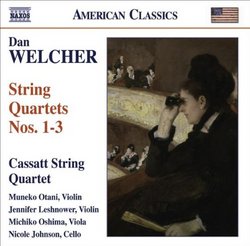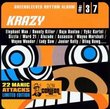| All Artists: Welcher, Cassatt String Quartet Title: Welcher: String Quartets Nos. 1-3 Members Wishing: 0 Total Copies: 0 Label: Naxos American Original Release Date: 1/1/2009 Re-Release Date: 8/25/2009 Genre: Classical Styles: Chamber Music, Historical Periods, Classical (c.1770-1830) Number of Discs: 1 SwapaCD Credits: 1 UPC: 636943938423 |
Search - Welcher, Cassatt String Quartet :: Welcher: String Quartets Nos. 1-3
 | Welcher, Cassatt String Quartet Welcher: String Quartets Nos. 1-3 Genre: Classical Named after the celebrated — American impressionist painter — Mary Cassatt, the Cassatt String — Quartet is ideally placed to interpret — the music of Dan Welcher, the main — theme from whose personable Third — String Quartet is... more » |
Larger Image |
CD DetailsSynopsis
Product Description Named after the celebrated American impressionist painter Mary Cassatt, the Cassatt String Quartet is ideally placed to interpret the music of Dan Welcher, the main theme from whose personable Third String Quartet is based on the artist's name and was written for this outstanding all-female ensemble. The good humored second quartet recalls Welcher's delightful experience of the magnificent harbor for which Sydney, Australia, is world famous, while his first, unnamed, quartet is by turns abrasive, melancholy, tragic, soothing, darkly comic and ultimately victorious in character. Orchestral works by Dan Welcher can be heard on Naxos 8.559287. Similar CDs
|
CD ReviewsThree Fine String Quartets by Dan Welcher J Scott Morrison | Middlebury VT, USA | 09/18/2009 (4 out of 5 stars) "Dan Welcher (b. 1948) is a composer whose works I have been hearing since the 1970s. He was trained as a pianist and bassoonist, was principal bassoon in the Louisville Orchestra, bassoonist and faculty member at the Aspen Music Festival and School for a number of years, and since 1978 has been a professor of music at the University of Texas in Austin. He has written in most forms, including opera and symphony -- his recent Fifth Symphony has received a lot of attention recently -- and has written three string quartets, the Third written for and named for the Cassatt String Quartet, the artists on this CD. On this disc the quartets are presented in reverse order.
The twenty-four minute-long Third Quartet is in three movements, each inspired by a painting by the notable American impressionist Mary Cassatt (1844-1926). The first movement is inspired by an 1876 painting, 'The Bacchante', which shows an exotic young woman playing a tambourine. The movement begins with lazy minor third tremolos that evoke a warm Latin day, perhaps Spanish, and then develops into a movement with Spanish rhythms tinged with French-impressionist harmonies. The second movement depicts Cassatt's 1878 painting, 'At the Opera'. A woman is using her opera glasses to look at something not on the stage but in a box opposite hers, perhaps a man. As if only half paid attention to by the woman, one hears strains from Gounod's 'Faust' (the Soldier's Chorus, and later Valentin's aria 'Avant de quitter ces lieux'). Movement Three, inspired by Cassatt's 1909 painting 'Young Woman in Green, Outdoors in the Sun', is filled with melodies, one of which is influenced by Debussy's mélodie, 'Green', from his 'Ariettes oubliées.' Of simple design, the three main melodies are presented ABCABC, with the tunes altered in their second appearances. One detects a sense of longing in this movement, perhaps reflective of Cassatt's failing eyesight at the time she created this painting. Welcher's eleven-minute one-movement Second Quartet (1992), subtitled 'Harbor Music', was inspired by a visit to the Sydney Harbor. In form, the movement is a kind of rondo, the recurring theme representing a ferry boat, and the other passages representing various sights around the Harbor that one reaches by ferry. The first embarcation on the ferry is in the form of a fanfare, but the final trip home on the ferry uses a rocking barcarolle rhythm that suggests it's time for a nap back at the hotel. The twenty-five minute First Quartet (1988) was composed on commission for the Cleveland Quartet (now, sadly, disbanded). The least immediately accessible of the three quartets, the composer says he 'aimed high' with this work and used a complicated numerological 'code' in its composition, a code that large determines not only melodies but rhythmic durations, pitches, harmonies and meters. None of this is, of course, apparent to the first-time listener. The work is more astringent than the later quartets and harder to get one's ears around. One does detect varieties of mood -- as in the first movement which is marked 'harsh, angry', or the second marked 'lonely'. The third movement is a scherzo with a diabolic/sardonic undertone that nonetheless has its moments of humor. The fourth movement is notable for its attempt to resolve earlier emotional conflicts between the various instruments and for its really quite masterful double fugue which leads to a triumphal conclusion. The Cassatt String Quartet -- whose members are Muneko Otani and Jennifer Leshnower, violins, Michiko Oshima, viola, and Nicole Johnson, cello -- was formed in 1985 with the encouragement of the Juilliard Quartet. Through their career they have given a good deal of attention to contemporary quartets, having given premières of quartets of Libby Larsen, Sebastian Currier and, of course, Dan Welcher. They play with precision, musicality and passion. Scott Morrison" |





